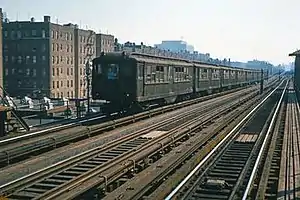Steinway Lo-V (New York City Subway car)
The Steinway Lo-V was a New York City Subway car type built from 1915 to 1925 by the Pressed Steel Car Company, American Car and Foundry, and Pullman Company. These cars were built specifically for use on the IRT Corona Line (currently known as the IRT Flushing Line, used by the 7 train), and the IRT Astoria Line (currently known as the BMT Astoria Line, used by the N and W trains). They had special gear ratios to climb the steep grades (4.5%) in the Steinway Tunnels, something standard IRT equipment could not do.[1]
| Steinway Lo-V | |
|---|---|
 A Steinway Lo-V train entering 167th Street | |
| Manufacturer | Pressed Steel Car Company, American Car and Foundry, Pullman Company |
| Constructed | 1915–1925 |
| Number built | 138 cars (138 motors) |
| Number preserved | 0 |
| Number scrapped | 138 |
| Fleet numbers | 4025–4036, 4215–4222, 4555–4576, 4700–4718, 4720–4771, 5628–5652 (all motors) |
| Capacity | 196: 44 (seated) 152 (standing) |
| Operator(s) | Interborough Rapid Transit Company New York City Transit Authority |
| Specifications | |
| Car body construction | Steel |
| Car length | 51 ft 6 in (15.70 m) |
| Width | 8 feet 11 5⁄16 inches (2.73 m) |
| Height | 12 feet (3.66 m) |
| Floor height | 3 ft 2 1⁄8 in (0.97 m) |
| Doors | 6 |
| Maximum speed | 60 mph (97 km/h) |
| Weight | ~ 74,000 lb (33,600 kg) |
| Traction system | Motor car: Westinghouse 577, General Electric 260 Air Compressor: WABCO D-2-F |
| Prime mover(s) | electric motor |
| Power output | 105 hp (78 kW) (WH 302, one car), 120 hp (89 kW) (WH 302F, 302F1, GE 240C, 259) |
| Electric system(s) | 600 V DC Third rail |
| Current collection method | Top running Contact shoe |
| Braking system(s) | WABCO Schedule AMUE with UE-5 universal valve, ME-23 brake stand, and simplex clasp brake rigging |
| Coupling system | WABCO J |
| Headlight type | incandescent light bulbs |
| Track gauge | 4 ft 8 1⁄2 in (1,435 mm) |
History
The Steinways were among the first Low-Voltage cars delivered to the IRT, starting with the 12 car order from Pressed Steel Car Company in 1915. Pullman then built and delivered at least 70 Steinway cars in 1916. In 1925, American Car and Foundry delivered 25 Steinway cars, which would be the last standard body IRT cars built. The last Steinways placed in service were 30 cars converted from former Flivver and Lo-V trailers. These cars were built as part of the 1915 and 1916 orders from Pullman.[2]
The Steinways served the Flushing and Astoria lines until 1950, when they were displaced by the R12, R14, and R15 cars. The Steinways were then transferred to the IRT Broadway–7th Ave–Van Cortlandt Park Line, where they were used with the Hi-Vs and few Lo-Vs until 1952, when they were transferred to the IRT Lexington Ave–Pelham Bay Local Line, joining the World's Fair Steinway cars, as well as other Hi-Vs remained in this service. In 1956, they were displaced by the arriving R17 cars, to other East Side and West Side lines, and remained until 1963, when most of these cars were retired. A small number remained on the fragment of the 3rd Ave El in the Bronx to finish out their years, until November 3, 1969. No examples of this car survive.
Similar cars
The 1938 World's Fair Lo-V was technically a "Steinway" car, as it also contained the special gear ratios required to climb the grades of the Steinway Tunnels. However, as the World's Fair Lo-V is significantly different, it is a separate and distinct car class and not included in the "Steinway" grouping.
See also
- Flivver Lo-V, a low voltage propulsion control IRT subway car built in 1915.
- Standard Lo-V, a low voltage propulsion control IRT subway car built from 1916 to 1925.
- World's Fair Lo-V, a low voltage propulsion control IRT subway car built in 1938.
References
- Sansone, Gene (2004). New York Subways. JHU Press. p. 84. ISBN 0-8018-7922-1.
- "www.nycsubway.org: Chapter 2, The IRT Subway". www.nycsubway.org. Retrieved December 11, 2017.
Further reading
- Gene Sansone, New York Subways: An Illustrated History of New York City's Transit Cars, ISBN 0-8018-7922-1, pp. 73–74, 78–80, 84–85, 95–96.